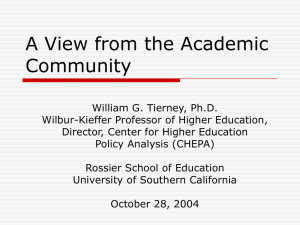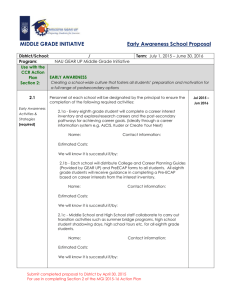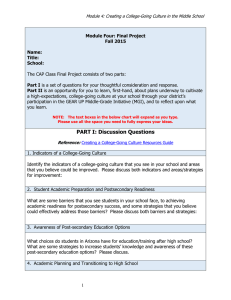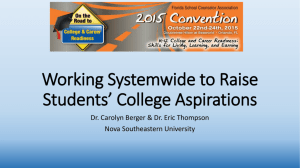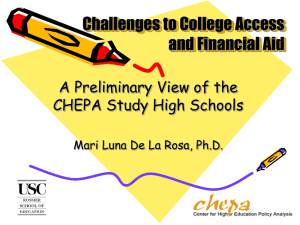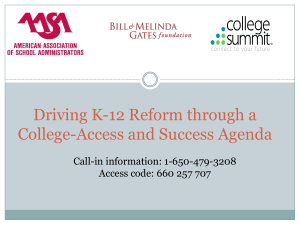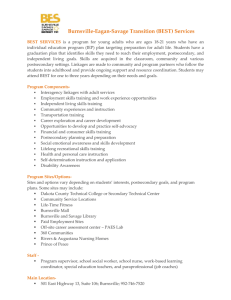School: - Northern Arizona University
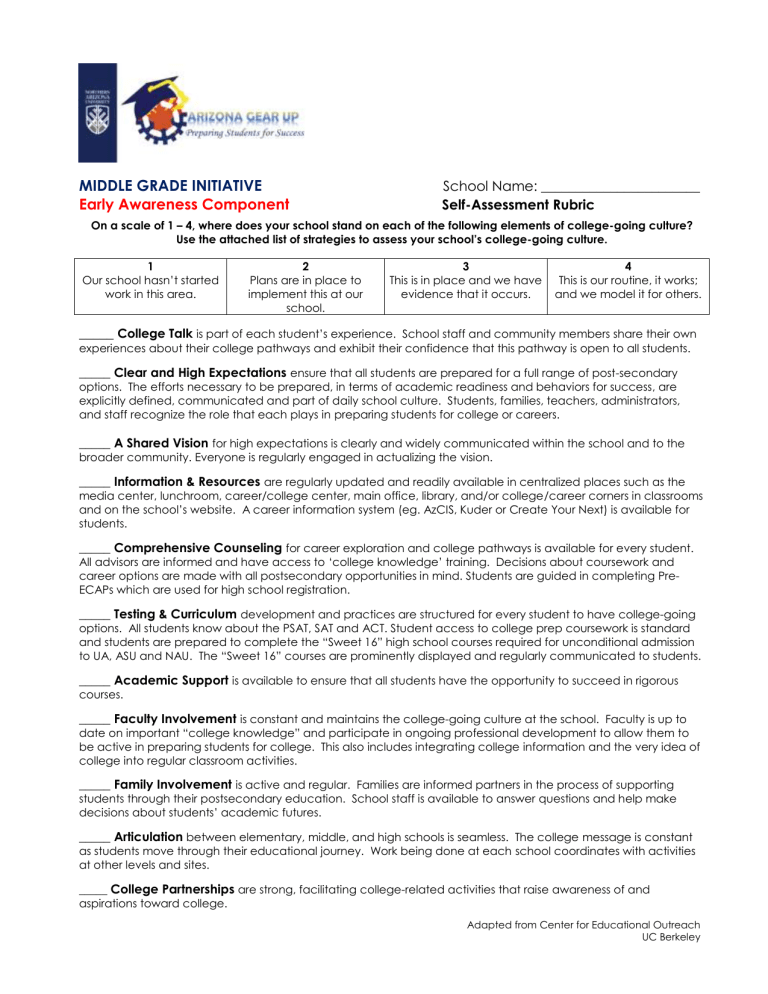
MIDDLE GRADE INITIATIVE
School Name: _______________________
Early Awareness Component
Self-Assessment Rubric
On a scale of 1 – 4, where does your school stand on each of the following elements of college-going culture?
Use the attached list of strategies to assess your school’s college-going culture.
1
Our school hasn’t started work in this area.
2
Plans are in place to implement this at our school.
3
This is in place and we have evidence that it occurs.
4
This is our routine, it works; and we model it for others.
_____
College Talk is part of each student’s experience. School staff and community members share their own experiences about their college pathways and exhibit their confidence that this pathway is open to all students.
_____ Clear and High Expectations ensure that all students are prepared for a full range of post-secondary options. The efforts necessary to be prepared, in terms of academic readiness and behaviors for success, are explicitly defined, communicated and part of daily school culture. Students, families, teachers, administrators, and staff recognize the role that each plays in preparing students for college or careers.
_____ A Shared Vision for high expectations is clearly and widely communicated within the school and to the broader community. Everyone is regularly engaged in actualizing the vision.
_____ Information & Resources are regularly updated and readily available in centralized places such as the media center, lunchroom, career/college center, main office, library, and/or college/career corners in classrooms and on the school’s website. A career information system (eg. AzCIS, Kuder or Create Your Next) is available for students.
_____ Comprehensive Counseling for career exploration and college pathways is available for every student.
All advisors are informed and have access to ‘college knowledge’ training. Decisions about coursework and career options are made with all postsecondary opportunities in mind. Students are guided in completing Pre-
ECAPs which are used for high school registration.
_____ Testing & Curriculum development and practices are structured for every student to have college-going options. All students know about the PSAT, SAT and ACT. Student access to college prep coursework is standard and students are prepared to complete the “Sweet 16” high school courses required for unconditional admission to UA, ASU and NAU. The “Sweet 16” courses are prominently displayed and regularly communicated to students.
_____ Academic Support is available to ensure that all students have the opportunity to succeed in rigorous courses.
_____ Faculty Involvement is constant and maintains the college-going culture at the school. Faculty is up to date on important “college knowledge” and participate in ongoing professional development to allow them to be active in preparing students for college. This also includes integrating college information and the very idea of college into regular classroom activities.
_____ Family Involvement is active and regular. Families are informed partners in the process of supporting students through their postsecondary education. School staff is available to answer questions and help make decisions about students’ academic futures.
_____ Articulation between elementary, middle, and high schools is seamless. The college message is constant as students move through their educational journey. Work being done at each school coordinates with activities at other levels and sites.
_____ College Partnerships are strong, facilitating college-related activities that raise awareness of and aspirations toward college.
Adapted from Center for Educational Outreach
UC Berkeley
Strategies and Activities for Building a College-Going Culture
Elements of
College-Going
Culture
College Talk
Clear and High
Expectations
The following strategies and activities represent a sampling of ideas that contribute to developing a College-Going Culture. The list is not exhaustive and is intended only to offer examples and invite discussion.
Additional space is provided for you to add additional activities at your school that reflect your attention to each element.
Helping Students DREAM
On designated days, all staff wear college memorabilia such as t-shirts, sweatshirts, etc., from their alma mater.
Designate one month per year as “College Awareness Month”. Host a variety of events and activities listed in this document in that month.
Staff display the name of their alma mater in or outside their classroom.
Teaching staff regularly speak to students about their educational journeys.
Students have opportunities to interview staff members about their educational journey.
Staff engage students in conversations about college as an option for them.
Teachers guide students in creating individual or group displays such as posters, books or bulletin boards on their college and career aspirations to display.
Teachers create visuals or bulletin board displays of their educational journeys and post them around the school where students can read them.
Teachers connect their subject matter with its relevance to college majors and careers.
Clear, visible statements in the school speak to the value and importance of college for students.
Parents and students are informed of the school’s expectation that all students will be prepared to succeed in college.
Students are encouraged to share their ideas and goals they have for their lives after high school.
Staff encourage students to take advanced placement classes in high school.
Teachers infuse the college-going culture in the classroom through rigor, fostering greater independence in students, the courage to take risks and persistence through failure.
Schools invite high school upperclassmen and recent alumni to share their college preparation experience, highlighting what they did and wished they had done in middle and high school.
Academic achievement awards are as prominently displayed and recognized as athletic achievements/awards.
Parents and students are informed of the school’s expectations that
A Shared Vision students attend school every day, unless ill, and indicate how attendance is related to academic achievement and lifelong success.
Parents and students are informed of the schools expectations related to behaviors for success and what those look like.
The school’s Vision Statement includes a commitment to supporting all students’ highest possible achievement.
The Vision Statement is clearly posted both inside and outside the school and on the school’s website.
All staff can quote the school’s Vision Statement and clearly articulate specific strategies and activities being undertaken to achieve it
All staff are actively engaged in creating and facilitating strategies and activities that will help the school actualize its vision.
Information &
Resources
Helping Students PLAN AND TRACK
Students are made aware of the options that are open to them with a college degree and those that are closed without a degree.
Eighth grade students and their families are provided the College &
Career Planning Guide, ideally in a workshop setting in which they are guided through the document.
Information about the types of financial aid available to pay for postsecondary education and ways to reduce the cost of college is provided to families through information posted at the school and on the school’s website, through workshops and counseling/advising.
Schools host college and career fairs and/or college and career speakers/presentations.
School counselors and staff post information about college and careers on bulletin boards and the school website.
Students present their career exploration research results in class, at a family event or during student led conferences.
Comprehensive
Counseling
Testing &
Curriculum
Every eighth grade student completes an interest inventory and explores/researches careers and the postsecondary pathways for achieving their career goals.
Eighth grade students receive guidance in completing a Pre-ECAP based on their career interests identified from an interest inventory.
Eighth grade students create an electronic portfolio to track all relevant post-secondary materials (Pre-ECAP, personal statements and resumes).
Pre-ECAPs are uploaded to students’ electronic portfolios if applicable.
Teachers and staff are sufficiently versed on a career information system (ex. AzCIS) and use it to engage students in exploration and planning of postsecondary options.
Eighth grade students receive guidance in registering for high school classes based on their Pre-ECAP, with attention paid to the “Sweet 16”
University prerequisites.
Counselors give “business card” with their photo, office location and hours to all students in their caseload.
All students participate in advisory groups/periods with curriculum that helps students develop behaviors for success including SMART goal setting, and time management.
Staff are designated to monitor absences daily and contact every student absent without an excuse, determine the reason and address barriers to attendance.
Helping Students WORK HARD
Staff discuss with students the importance of the PSAT, ACT and SAT for college admission and scholarships.
Students are provided opportunities to take timed tests with formats similar to these standardized college entrance exams as preparation.
Academic Support
Faculty
Involvement
Family
Involvement
Staff regularly examine formative (through-course) student achievement data to identify students who need additional support.
Identified students receive in-school (e.g., re-teach/enrich; lab) and out-of school (e.g., before or after school) tutoring, homework help, and remediation.
Students with attendance or behavior problems, who would have formerly been expelled, assigned to detention or in school suspension, are placed into an intensive support class. Staff is trained and engaged in helping develop students’ academic foundational skills, executive function, self-regulation and sense of place and purpose in the school.
Staff regularly integrate college-going-related conversations and activities in their classrooms.
Teachers are up-to-date on important “college knowledge”.
At least one school counselor, teacher or administrators has participated in the on-line Arizona College Access Professional (CAP)
Course
Parents are provided information about the value of a college education and the doors it opens for their children.
Resources and staff are available at the school to support college aspirations and families are provided information about how to access this support. Families are warmly welcomed when they inquire.
Community members with college degrees serve (volunteer) as college/career coaches who share their experiences with students and families about preparing for and attending college.
Students’ career interest inventory results and related research is shared with parents.
Articulation
College
Partnerships
Helping Students TRANSITION
Schools have transition staff who ensure that students have completed the appropriate coursework to matriculate to the next grade level and to college.
Contact person(s) for articulation is known and dispersed.
Articulation between elementary, middle and high schools is seamless.
The college-going message is constant as students move through their educational journey.
Instruction is aligned across grades.
Middle School and High School staff collaborate to carry out transition
activities, such as summer bridge programs, high school studentshadowing days, high school tours, etc. for all eighth grade students.
Student’s electronic portfolios and Pre-ECAPs carry forward to high school counselors.
Schools develop partnerships with 4-year and 2-year colleges.
Partner colleges facilitate/host college-related activities for students and families and raise awareness of, and aspirations for, college.
